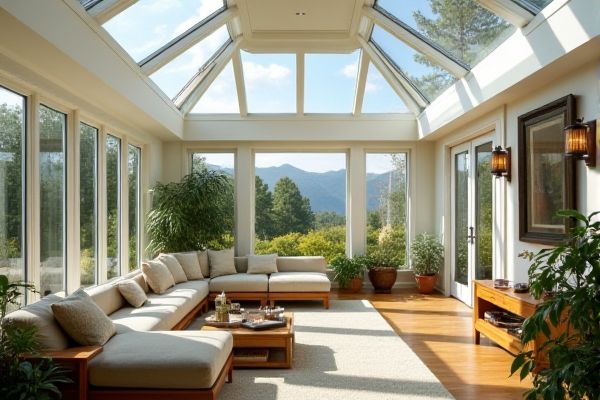
Operable skylights in sunrooms offer the advantage of ventilation, allowing fresh air to circulate and helping regulate indoor temperature, while fixed skylights provide consistent natural light without the option to open. Understanding these differences can help you choose the ideal skylight to enhance Your sunroom comfort and energy efficiency; explore the rest of this article to find the perfect solution for Your space.
Table of Comparison
| Feature | Operable Skylights | Fixed Skylights |
|---|---|---|
| Ventilation | Provides natural airflow, improves air circulation | No ventilation, sealed units |
| Energy Efficiency | Allows heat release, can reduce cooling costs | Better insulation, reduces heat loss |
| Natural Light | Adjustable light entry depending on opening | Constant natural light exposure |
| Maintenance | Requires regular checks for mechanism functionality | Low maintenance, no moving parts |
| Installation Cost | Generally higher due to moving parts | Lower installation cost |
| Weather Resistance | May need extra sealing, vulnerable to leaks if not maintained | Highly weatherproof and leak-resistant |
| Use Case | Ideal for sunrooms needing ventilation and temperature control | Best for fixed daylighting without airflow needs |
Introduction to Sunroom Skylights
Sunroom skylights enhance natural light and ventilation, offering two main types: operable and fixed. Operable skylights provide the flexibility to open and close, allowing fresh air circulation and temperature control in Your sunroom. Fixed skylights, while non-opening, maximize sunlight exposure and offer superior insulation for consistent indoor comfort.
What Are Operable Skylights?
Operable skylights in a sunroom are designed to open and close, allowing you to control ventilation and natural airflow. These skylights enhance indoor air quality by reducing humidity and heat buildup, making your sunroom more comfortable year-round. Unlike fixed skylights, operable models provide customizable climate control while maintaining natural light.
Understanding Fixed Skylights
Fixed skylights in sunrooms offer maximum natural light without ventilation, providing a durable, leak-resistant design that requires minimal maintenance. These skylights enhance energy efficiency by reducing heat loss and preventing drafts, making your sunroom energy-smart year-round. Choosing fixed skylights ensures a sleek, uninterrupted view of the sky while maintaining structural integrity and weatherproofing.
Benefits of Operable Skylights in Sunrooms
Operable skylights in sunrooms provide enhanced ventilation, allowing fresh air to circulate and regulate indoor temperature naturally. These skylights improve energy efficiency by reducing the need for air conditioning and promoting passive cooling. Additionally, operable skylights offer flexible daylight control, enhancing comfort and creating a more enjoyable living space.
Advantages of Fixed Skylights for Sunrooms
Fixed skylights in sunrooms offer superior insulation and energy efficiency due to their airtight seals, reducing heat loss and preventing drafts. Their simpler design ensures lower maintenance and enhanced durability, making them a long-lasting choice for consistent natural light without operational complications. The unobstructed glass area in fixed skylights maximizes sunlight entry, brightening the sunroom and improving overall ambiance.
Energy Efficiency: Operable vs Fixed Skylights
Operable skylights in sunrooms enhance energy efficiency by allowing natural ventilation that reduces reliance on air conditioning, while fixed skylights provide consistent daylight without heat exchange control. Fixed skylights offer superior insulation as their sealed design minimizes air leaks, effectively retaining indoor temperature. Choosing between operable and fixed skylights depends on balancing ventilation needs and thermal performance for optimized energy savings.
Ventilation and Airflow Considerations
Operable skylights in sunrooms enhance natural ventilation by allowing fresh air to flow in and hot air to escape, reducing indoor temperature and improving air quality. Fixed skylights, while providing abundant natural light, do not offer airflow benefits, potentially leading to higher indoor heat and stagnant air. Selecting operable skylights supports better climate control and comfort in sunroom environments.
Installation and Maintenance Differences
Operable skylights in sunrooms require more complex installation, including ventilation systems and secure sealing to prevent leaks, while fixed skylights involve simpler, quicker installation with fewer components. Maintenance for operable skylights is more frequent, as their moving parts need regular inspection, lubrication, and cleaning to ensure smooth operation. Your choice between operable and fixed skylights affects not only the ease of installation but also the ongoing effort and cost to keep the sunroom comfortable and leak-free.
Aesthetic Impact: Design and Light Quality
Operable skylights in a sunroom enhance aesthetic impact by allowing natural light to flow dynamically, creating vibrant, changing patterns throughout the day, while fixed skylights provide a consistent, unaltered light quality that maintains a sleek and minimalist design. Your choice affects the overall atmosphere, with operable skylights offering ventilation and interactive light experience, contrasted with the fixed option's seamless integration and uninterrupted views. Both options elevate the sunroom's visual appeal, but operable skylights introduce functional versatility alongside sophisticated lighting effects.
Choosing the Right Skylight for Your Sunroom
Choosing the right skylight for your sunroom depends on ventilation needs and maintenance preferences. Operable skylights offer enhanced airflow control, allowing You to regulate temperature and reduce humidity, making them ideal for comfort and energy efficiency. Fixed skylights provide maximum insulation and uninterrupted natural light, reducing energy costs while requiring less upkeep.
 homyna.com
homyna.com